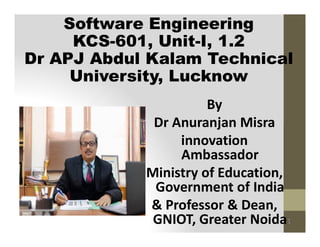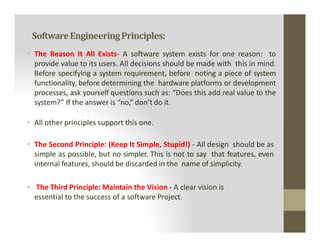Ad
Various Process of Software Engineering notes
- 1. Software Engineering KCS-601, Unit-I, 1.2 Dr APJ Abdul Kalam Technical University, Lucknow By Dr Anuranjan Misra 1 Dr Anuranjan Misra innovation Ambassador Ministry of Education, Government of India & Professor & Dean, GNIOT, Greater Noida
- 3. THESOFTWAREPROCESS • A process is a collection of activities, actions, and tasks that are performed when some work product is to be created. • An activity strives to achieve a broad objective (e.g., communication with stakeholders) and is applied regardless of the application domain, size of the project, complexity of the effort, or degree of rigor with which software engineering is to be applied. • An action encompasses a set of tasks that produce a major work • An action encompasses a set of tasks that produce a major work product (e.g., an architectural design model). • A task focuses on a small, but well-defined objective (e.g., conducting a unit test) that produces a tangible outcome. • A process framework establishes the foundation for a complete software engineering process by identifying a small number of framework activities that are applicable to all software projects, regardless of their size or complexity. In addition, the process framework encompasses a set of umbrella activities that are applicable across the entire software process.
- 4. THESOFTWAREPROCESS A generic process framework for software engineering encompasses five activities: Communication - Before any technical work can commence, it is critically important to communicate and collaborate with the customer (and other stakeholders The intent is to understand stakeholders’ objectives for the project and to gather requirements that help define software features and functions. Planning - Any complicated journey can be simplified if a map exists. The map - called a software project plan - defines the software engineering work by describing the technical tasks to be conducted, the risks that are likely, the resources that will be required, the work engineering work by describing the technical tasks to be conducted, the risks that are likely, the resources that will be required, the work products to be produced, and a work schedule. Modeling - A software engineer creating models to better understand software requirements and the design that will achieve those requirements. Construction-This activity combines code generation (either manual or automated) and the testing that is required to uncover errors in the code. Deployment-The software (as a complete entity or as a partially completed increment) is delivered to the customer who evaluates the delivered product and provides feedback based on the evaluation.
- 5. Software engineering process framework activities are complemented by a number of umbrella activities. Typical umbrella activities include: Software project tracking and control—allows the software team to assess progress against the project plan and take any necessary action to maintain the schedule. Risk management—assesses risks that may affect the outcome of the project or the quality of the product. Software quality assurance—defines and conducts the activities required to ensure software quality. Technical reviews—assesses software engineering work products in an effort to uncover and remove errors before they are propagated to the next activity. activity. Measurement—defines and collects process, project, and product measures that assist the team in delivering software that meets stakeholders’ needs; can be used in conjunction with all other framework and umbrella activities. Software configuration management—manages the effects of change throughout the software process. Reusability management—defines criteria for work product reuse (including software components) and establishes mechanisms to achieve reusable components. Work product preparation and production—encompasses the activities required to create work products such as models, documents, logs, forms, and lists.
- 6. SOFTWAREENGINEERINGPRACTICES The Essence of Practice • Understand the problem (communication and analysis) • Plan a solution (software design) • Plan a solution (software design) • Carry out the plan (code generation) • Examine the result for accuracy (testing and quality assurance)
- 7. SoftwareEngineeringPrinciples: • The Reason It All Exists- A software system exists for one reason: to provide value to its users. All decisions should be made with this in mind. Before specifying a system requirement, before noting a piece of system functionality, before determining the hardware platforms or development processes, ask yourself questions such as: “Does this add real value to the system?” If the answer is “no,” don’t do it. • All other principles support this one. • All other principles support this one. • The Second Principle: (Keep It Simple, Stupid!) - All design should be as simple as possible, but no simpler. This is not to say that features, even internal features, should be discarded in the name of simplicity. • The Third Principle: Maintain the Vision - A clear vision is essential to the success of a software Project.
- 8. • The Fourth Principle: What You Produce, Others Will Consume Always specify, design, and implement knowing someone else will have to understand what you are doing. The audience for any product of software development is potentially large. Specify with an eye to the users. • The Fifth Principle: Be Open to the Future - A system with a long lifetime has more value. these systems must be ready to adapt to these and other changes. adapt to these and other changes. • The Sixth Principle: Plan Ahead for Reuse - Reuse saves time and effort. The reuse of code and designs has been major benefit of using object-oriented technologies. • The Seventh principle: Think! - Placing clear, complete thought before action almost always produces better results. When you think about something, you are more likely to do it right. You also gain knowledge about how to do it right again. If you do think about something and still do it wrong, it becomes a valuable experience
- 9. SOFTWARE MYTHS Software myths—erroneous beliefs about software and the process that is used to build it—can be traced to the earliest days of computing. Today, most knowledgeable software engineering professionals recognize myths for what they are—misleading attitudes that have recognize myths for what they are—misleading attitudes that have caused serious problems for managers and practitioners alike. However, old attitudes and habits are difficult to modify, and remnants of software myths remain. 1)Management myths 2)Customer myths 3)Practitioner myths
- 10. Management myths. Managers with software responsibility, like managers in most disciplines, are often under pressure to maintain budgets, keep schedules from slipping, and improve quality. Myth: We already have a book that’s full of standards and procedures for building software. Won’t that provide my people with everything they need to know? with everything they need to know? Reality: The book of standards may very well exist, but is it used? Are software practitioners aware of its existence? Does it reflect modern software engineering practice? Is it complete? Is it adaptable? Is it streamlined to improve time- to-delivery while still maintaining a focus on quality? In many cases, the answer to all of these questions is “no.”
- 11. Customer myths. A customer who requests computer software may be a person at the next desk, a technical group down the hall, the marketing/sales department, or an outside company that has requested software under contract Myth: A general statement of objectives is sufficient to begin writing programs—we can fill in the details later. begin writing programs—we can fill in the details later. Reality: Although a comprehensive and stable statement of requirements is not always possible, an ambiguous “statement of objectives” is a recipe for disaster. Unambiguous requirements (usually derived iteratively) are developed only through effective and continuous communication between customer and developer.
- 12. Practitioner’s myths. Myths that are still believed by software practitioners have been fostered by over 50 years of programming culture. During the early days, programming was viewed as an art form. Old ways and attitudes die hard. Myth: Once we write the program and get it to work, our job is done. job is done. Reality: Someone once said that “the sooner you begin ‘writing code,’ the longer it’ll take you to get done.” Industry data indicate that between 60 and 80 percent of all effort expended on software will be expended after it is delivered to the customer for the first time.



































































